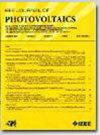第四组硅基中红外热光伏电池
IF 2.5
3区 工程技术
Q3 ENERGY & FUELS
引用次数: 0
摘要
化合物半导体已经成为当前中红外热光伏器件的主要组成部分,这些器件涉及到2000美元以下,1000美元以下的热量转换和功率光束。然而,与这些技术相关的过高成本限制了它们的广泛采用。为了缓解这一挑战,我们在硅片上直接引入了由GeSn合金组成的全IV族中红外电池。这类新兴的半导体提供应变和组成作为自由度来控制带隙能量,从而覆盖整个中红外范围。所提出的热光伏器件由完全松弛的Ge$ {0.83}$Sn$ $ $ {0.17}$ $p$-$i$-$n$同结组成,对应的带隙能量为$0.29 \,\ mathm {e\ mathm {V}}$。导出了一个理论框架来评估高注射下电池的性能。考虑相干/非相干层的混合叠加,采用广义传递矩阵法研究了黑体的辐射吸收。此外,本征复合机制及其在窄带隙半导体中的重要性也得到了考虑。在这方面,抛物线带近似和费米黄金法则相结合,以准确估计辐射复合率。基于这些分析,预测在500 - 1500 \,\数学{K}$范围内的黑体辐射下,Ge$ {0.83}$Sn$ ${0.17}$热光伏电池的功率转换效率高达9%。在正面照明下,效率略有提高,但在800美元以下就消失了,而在黑体温度范围内,使用背面反射器提高了效率。并对异质结构厚度、表面复合速度和载流子寿命的影响进行了阐述和讨论。本文章由计算机程序翻译,如有差异,请以英文原文为准。
Group IV Mid-Infrared Thermophotovoltaic Cells on Silicon
Compound semiconductors have been the predominant building blocks for the current midinfrared thermophotovoltaic devices relevant to sub-$2000 \,\mathrm{K}$ $_{0.83}$ $_{0.17}$ $p$ $i$ $n$ $0.29 \,\mathrm{e\mathrm{V}}$ $_{0.83}$ $_{0.17}$ $1500 \,\mathrm{K}$ $800 \,\mathrm{K}$
求助全文
通过发布文献求助,成功后即可免费获取论文全文。
去求助
来源期刊

IEEE Journal of Photovoltaics
ENERGY & FUELS-MATERIALS SCIENCE, MULTIDISCIPLINARY
CiteScore
7.00
自引率
10.00%
发文量
206
期刊介绍:
The IEEE Journal of Photovoltaics is a peer-reviewed, archival publication reporting original and significant research results that advance the field of photovoltaics (PV). The PV field is diverse in its science base ranging from semiconductor and PV device physics to optics and the materials sciences. The journal publishes articles that connect this science base to PV science and technology. The intent is to publish original research results that are of primary interest to the photovoltaic specialist. The scope of the IEEE J. Photovoltaics incorporates: fundamentals and new concepts of PV conversion, including those based on nanostructured materials, low-dimensional physics, multiple charge generation, up/down converters, thermophotovoltaics, hot-carrier effects, plasmonics, metamorphic materials, luminescent concentrators, and rectennas; Si-based PV, including new cell designs, crystalline and non-crystalline Si, passivation, characterization and Si crystal growth; polycrystalline, amorphous and crystalline thin-film solar cell materials, including PV structures and solar cells based on II-VI, chalcopyrite, Si and other thin film absorbers; III-V PV materials, heterostructures, multijunction devices and concentrator PV; optics for light trapping, reflection control and concentration; organic PV including polymer, hybrid and dye sensitized solar cells; space PV including cell materials and PV devices, defects and reliability, environmental effects and protective materials; PV modeling and characterization methods; and other aspects of PV, including modules, power conditioning, inverters, balance-of-systems components, monitoring, analyses and simulations, and supporting PV module standards and measurements. Tutorial and review papers on these subjects are also published and occasionally special issues are published to treat particular areas in more depth and breadth.
 求助内容:
求助内容: 应助结果提醒方式:
应助结果提醒方式:


